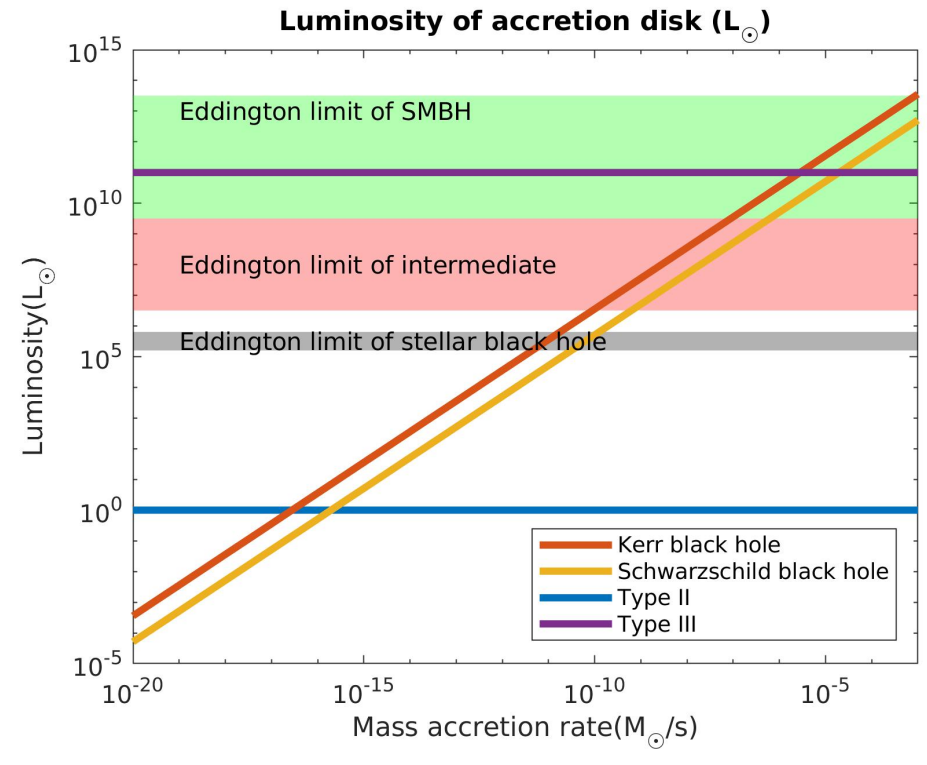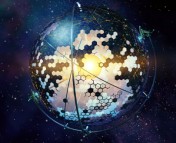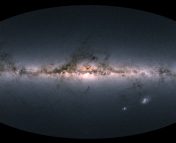Title: A Dyson Sphere around a black hole
Authors: Tiger Yu-Yang Hsiao, Tomotsugu Goto, Tetsuya Hashimoto, Daryl Joe D. Santos, Alvina Y. L. On, Ece Kilerci-Eser, Yi Hang Valerie Wong, Seong Jin Kim, Cossas K.-W. Wu, Simon C.-C. Ho, Ting-Yi Lu
First Authors Institution: Institute for Astronomy, National Tsing Hua University, Taiwan
Status: Published in MNRAS (closed access, but available on arXiv)
Civilizations need to harvest energy. This is not only the case for humanity but also for extraterrestrial civilizations. We do not know what kind of technology aliens use, but it must require energy. A popular way to classify alien civilizations is by their energy consumption with the Kardashev scale (explained in this bite). Type I civilizations use all the energy of their home planet. Type II civilizations use all the power of their home star, and Type III civilizations use the energy from all stars in their home galaxy. Humanity does not even classify as a Type I civilization on this scale, so we are relatively unadvanced from a cosmic perspective. But how could more advanced aliens obtain enough energy to progress beyond type II, ? Todays’ paper discusses an intriguing possibility: harvesting black holes.
Dyson spheres – capturing energy with a mega-constellation
One possible way to obtain energies on astronomical scales is with a Dyson sphere. This is a structure surrounding an energy source like a star or a black hole, capturing the sources’ energy. One example would be a sphere around the sun made up of solar panels, which capture all the sun’s light.
The most popular type of Dyson sphere is a Dyson shell, which completely encases the source. They occasionally feature in Science Fiction (for example, in Star Trek TNG) but are not realistic from a physics perspective. Such a shell would require large amounts of material and would be unstable. Gravity would pull it towards its centre, causing it to collapse, unless large amounts of energy were used to counteract the pull.
A more feasible concept is a Dyson bubble: A Dyson sphere made up of millions of individual satellites – a mega-constellation (see Fig.1). These satellites are positioned such that the radiation pressure from the energy source counteracts the gravitational pull. In that way, the satellites can remain in orbit for a long time and collect energy.

Figure 1: Illustration of a Dyson Bubble. Each dot represents a satellite that collects energy from the source at the centre of the bubble. From https://commons.wikimedia.org/w/index.php?curid=2230244
Capturing the energy of a black hole – but which type? And is it enough?
Originally, Dyson spheres were envisioned to surround a single star and provide energy to a civilization somewhere between type I and type II. To go beyond type II, though, you need a different source. Todays’ authors suggest an exciting prospect: black holes.
Naively, one would assume that a Dyson sphere cannot work around a black hole. After all, black holes derive their name because even light cannot escape from them once it reaches the black hole’s event horizon. So, how could a Dyson sphere around a black hole capture any energy?
Well, while black holes themselves cannot radiate from inside their event horizon, matter falling into the black hole emits large amounts of energy. The most promising ways infalling matter could power a Dyson sphere described in the paper are radiation by accretion disks and relativistic jets.
Accretion disks form around any black hole that is currently “feeding”. The matter falling onto the black hole creates a disk-like structure that rotates around the event horizon. Because of the strong gravitational pull of the black hole, the material is accelerated and heated up (to up to a million Kelvin!). It then starts converting parts of its mass into radiation. This process is surprisingly effective and can produce large amounts of radiation. The actual amount depends on the mass accretion rate, i.e. how fast mass falls onto the black hole. The luminosity of the radiation is limited by the black hole’s mass. If the luminosity of the radiation is too high compared to the gravity of the black hole, radiation pressure pushes the disk away, which stops the accretion. The maximal luminosity is called the Eddington limit.
The authors calculated the energy output of the accretion disks around rotating black holes (Kerr black holes) and stationary ones (Schwarzschild black holes) (see Fig 2). They compared them to the energy required by Type II and Type III civilizations. They find that the accretion disk of even a stellar-mass black hole could yield enough power for a beyond-Type II civilization. The accretion disk of a single supermassive black hole could power a Type III civilization on its own!

Figure 2: Expected luminosity of black holes depending on how fast matter is infalling (red and yellow lines). Rotating (Kerr) black holes have a slightly higher efficiency than stationary (Schwarzschild) black holes, so they are generally brighter. The blue and purple lines show the energy required for a Type II and Type III civilization, respectively. The grey area is the maximal luminosity of a stellar black hole, the red area is the maximal luminosity of an intermediate-mass black hole, and the green area is the maximal luminosity of a supermassive black hole. (Fig. 1 in the paper)
The second energy sources associated with a black hole are its relativistic jets. These jets are made of charged particles that were falling into the black hole but are then ejected outwards along a beam roughly perpendicular to the accretion disk and accelerated to almost the speed of light. They provide two kinds of energy. First, the jets emit radiation, mostly in radio frequencies. The authors calculate that the jets of supermassive black holes radiate about 60% as much energy as the accretion disk. For stellar black holes, even 80% of the accretion disk energy is reached. Second, the jets themselves consist of highly accelerated particles. The kinetic energy of these particles could be harvested, for example, with solar sails (see this astrobite). The authors find that the kinetic energy of the jets yield an additional 10% of the total jet energy.
So together the accretion disk and jets of a black hole emit enormous amounts of energy. Consequently, a Dyson sphere could power a beyond-Type II civilization, even if it could harvest only a few per cent of the energy. Of course, humanity is still far away from such energy consumption. But, could these Dyson spheres give us a clue where to find an advanced alien civilization?
So, can we find these Dyson spheres?
Dyson spheres could be detected directly by finding sources that are dimmer than expected. For example, this astrobite describes how the Gaia satellite is used to search for Dyson spheres around stars. If there is a Dyson sphere around a star, it would partially obscure the star, making it appear dimmer. However, this is not really an option for the Black-Hole Dyson spheres, because we do not know how bright the accretion disk of a black hole is. Suppose black hole A has an accretion disk 10 times as bright as black hole B. In this case, either there is a Dyson sphere around black hole B harvesting 90% of the energy or black hole A currently swallows 10 times as much matter as black hole B. The second alternative is much more plausible.
Nevertheless, the authors suggest another way that we could detect Dyson spheres – via their waste heat. The energy absorbed by a Dyson sphere cannot be entirely converted into “useful” energy like electricity. A part of the energywill heat up the sphere itself. Consequently, the sphere emits heat radiation in the near-infrared – the same kind of radiation you can see with night-vision goggles. This heat radiation could be detectable.
The authors calculate the expected spectrum of a stellar black hole + Dyson sphere system for a Dyson sphere that can withstand up to 3000 K (2727°C or 4940°F) and is 10kpc away from us, shown in Fig 3. The Dyson sphere adds a remarkable “bump” in the infrared range. This bump is above the detection limits of several current telescopes, so it might be detectable! However, the authors caution that the calculation does not include the effect of dust, which also emits head radiation in the infrared range. So, the Dyson sphere signal might be obscured by this additional source.

Figure 3: Spectrum for a Stellar black hole + Dyson Sphere set up at 10 kpc distance from the observer. The accretion disk of the black hole radiates mostly in the X-ray and UV wavelengths; the Dyson sphere adds a “bump” in the Near- and Midinfrared (NIR and MIR). The points show the minimum flux detectable by various telescopes. The “bump” is higher than these limits, so it might be detectable. (Fig. 3 in the paper)
So, in conclusion, black holes could be the power source for advanced alien civilizations, and we might even be able to detect them!
Astrobite edited by Katy Proctor
Featured Image Credit: NASA JPL/NRAO/AUI/NSF/NASA





Black matter is NOT something to be tampered with. With this tampering/harvesting comes the end of the human race.
ok alex
L Bozo